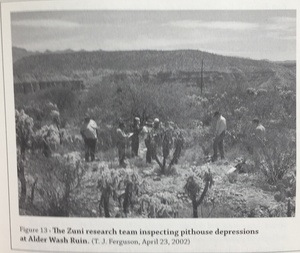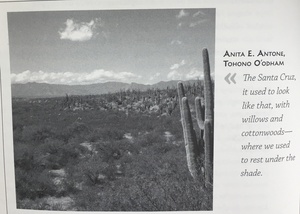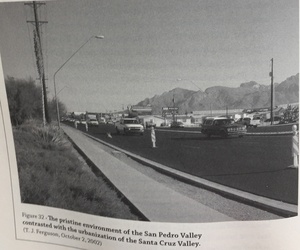The San Pedro Ethnohistory Project
There have been projects to investigate and map archaeological sites in the San Pedro Valley, a 50 mile long valley in Cochise County, Arizona. Ancient villages, steep terraces, petroglyphs and pictographs have been found, with over 500 distinct sites covering thousands of years of human history. The San Pedro Ethnohistory Project was created to understand these archaeological finds. The project is the subject of the book, "History Is In The Land: Multivocal Tribal Traditions in Arizona's San Pedro Valley," by .J. Ferguson and Chip Colwell-Chanthaphonh.
The San Pedro Ethnohistory Project sought to record the tribal traditions and voices of Native Americans who had occupied these archaeological sites. The project began in 1999, organized through the Center for Desert Archaeology in Tucson Arizona. Principal investigators were T.J. Ferguson, Roger Anyon, and Chip Colwell-Chanthaphonh. They collaborated with Committees and Advisory Teams from various tribes: the Tohono O'odham, Hopi, Zuni, and San Carlos and White Mountain Apache tribes.
Field work was conducted at archaeological sites. Artifacts from The Amerind Foundation Museum and the Arizona State Museum were reviewed. Conversational interviews with members of the tribes were conducted to collect qualitative data. Much of the work was done in native languages, and translated into English by tribal representatives. Notes, photographs, and video was used.
Research themes included the history of migration, the role of warfare and conflict, social identity, subsistence ecology, and population dynamics.
The goal was to create historical narratives using as many research sources as possible, including oral histories, traditional knowledge, ethnography, documentary records, and archaeology. It also was to contribute to future efforts to preserve cultural resources in the San Pedro Valley. Development and tourism threaten the natural and historic fabric of the San Pedro Valley. The project is an effort to provide information to scholars and the general public that can be used in managing the San Pedro Valley.
The theory was that cultural landscapes are history, and archaeological sites are monuments. The tribes use cultural landscape to construct their current social identities. Cultural landscape include the scenery, combined with an intellectual component. The land is the canvas, from which the different tribes paint not only their history, but understand their present identity. The project studied how the natural areas interacted with the culture, to create the cultural landscape. The American Indians experience the landscape through stories and place names. There are mental images that accompany seeing landscapes that are Integral to understanding and perceiving the landscape. The viewers perception becomes part of the landscape.
The project attempted to view these archaeological sites not just as scientific resources, but as monuments commemorating the past. Talking to Native Americans to understand the stories and place names about the physical landscape was essential to depicting the cultural landscape.
They took representatives of four tribes to six archaeological sites in the San Pedro Valley, representing late agricultural periods in the archaeological timeline.
They discussed Hohokam archaeology with tribal research teams at Alder Wash Ruin and Soza Ballcourt.
They visited pithouses at Babocomari and Tres Alamos. They visited Western Pueblo sites, including Reeve Ruin and Davis Ranch Site. They visited other Sobaipuri sites, the Terrenate Site, and Camp Grant. They visited Gaybanipitea., the Flieger Site,, the Bayless Ruin, ++++++++++++
By studying collections at the Amerindian Foundation Museum and Arizona State Museum with tribal advisors, and recording stories about items, they gained insight about not only the artifacts, but also traditions and origins of the tribes.
They discuss the Santa Cruz River, how it traditionally watered fields for the Tohono O'odham Reservation, and how it is now a desiccated wash with dwindling vegetation and little animal life, basically a dry wash, as the area around it has been urbanized by Tucson development.
They discussed petroglyphs sites with the advisors. as well as artifacts.
Each of the four tribes had representatives, and different perspectives.
They studied Apache trails in the Aravaipa Canyon, and visited the Apache settlement of Gashdla'a Cho O'aa, and recorded the stories by the San Carlos Apache of the Camp Davis Massacre.
They reviewed the many Apache place names, names which inspired stories and instill a sense of identity and belonging. They discuss a cave at the beginning of Aravaipa Canyon named Tse Ya Goges Chin, an ancient site where there are painted pictures.









